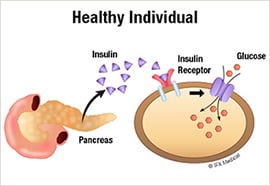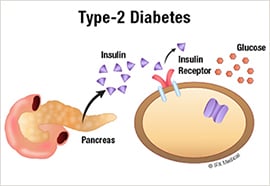Type-2 diabetes is a serious medical condition in which the body is unable to properly process sugar, or glucose from food. As a result, blood sugar levels increase resulting in damage to nerves and organs.
The number of people diagnosed with type-2 diabetes has increased dramatically in recent years. Aging baby boomers and high rates of obesity are among the main causes for the approximately 8% annual increase in people being diagnosed with diabetes.
Factors that increase your risk for type-2 diabetes include:

- Age
- Weight
- Inactivity
- A diet high in sugar and fat
- Family history of the disease
Causes of Diabetes
Type-2 diabetes develops when sugar in the blood is not properly used by the cells, allowing it to build-up in the bloodstream.
Blood sugar, or glucose, serves an important role in the body. When absorbed by the body’s cells, it is converted into fuel and used for energy. A hormone produced by the pancreas, insulin, helps the cells to absorb glucose to encourage its conversion into fuel.
In a healthy individual, insulin serves as a key to a lock, allowing glucose to pass into the cell. In an individual with type-2 diabetes, the cells become resistant to insulin. This prohibits glucose from effectively entering the cell. Left in the bloodstream, the increasing levels of glucose lead to high blood sugar.


The cells’ increasing resistance to insulin develops gradually. The onset of this issue is known as pre-diabetes, a reversible stage of the disease that will generally lead to type-2 diabetes within 10 years.
Symptoms of Type-2 Diabetes
Often, type-2 diabetes will develop without immediately presenting symptoms. As the condition grows more severe, symptoms will often include:
- Fatigue
- Excessive thirst
- Frequent urination
- Hunger, even after just eating
- Infections that are slow to heal
- Blurred vision
- Erectile dysfunction
Treatment for Type-2 Diabetes
The goal of treatment for type-2 diabetes is to manage blood sugar levels to prevent health complications from the disease. This is accomplished through a collection of lifestyle changes and medications. This often includes eating a diet low in sugar and fat, exercising regularly and paying attention to your blood sugar levels.
Medications and insulin injections are sometimes prescribed to help manage blood sugar levels.
The most effective treatment for uncontrolled type-2 diabetes is weight loss. Following weight loss surgery, many people experience rapid improvement in their health, including the reversal and resolution of type-2 diabetes.
Suggested Reading
Clayton: Health Improvement
For Diabetes, Surgery a Better Option than Standard Treatment
Health Risks Associated with Obesity
Also In This Section
- Bariatric Surgery May Restore Monthly Cycles in Obese Women
- Bariatric Surgery May Prevent Heart-Related Incidents
- For Diabetes, Surgery a Better Option than Standard Treatment
- Help Cholesterol by Losing Weight
- Speaking With Your Physician May Enhance Your Weight Loss Efforts
- Improve Migraines with Weight Loss Surgery
- Flu Shot Less Effective for the Obese
- Benefits of Weight Loss before Bariatric Surgery
- Keep Up with Weight Loss
- Warm Up Your Body Even In Cold Weather
- Life after Weight Loss Surgery
- Health Risks Associated with Obesity
- Ten Reasons You Should Lose Weight
- Bariatric Surgery Can Help You to Fight Obesity
- How to Begin Exercising After Gastric Bypass Surgery
- New Risk Calculator Assists Patients Considering Bariatric Surgery

